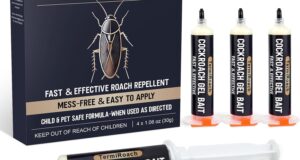Roach monitoring is a key step for managing pests. Cockroaches cause unease. They hurt our health by placing bacteria on food and surfaces. Early checks catch roaches before they grow into a large group that can damage rooms and workspaces. This article shows roach check tips and gives steps for roach control in homes and offices.
Why is Roach Monitoring Important?
Roach checks let owners and pest experts spot roaches early. Without checks, roach groups grow fast. This growth makes removal hard and costs more time and money. Checks help to:
• See which roach types exist
• Find where roaches hide and breed
• Count roaches and mark their spread
• Judge if control steps work
Watch roach movements. Use the data to apply smart care fast.
Common Roach Monitoring Techniques
There are several ways to track roaches. Each method needs low impact on daily life and works in its own way. When you combine these methods, they give a clear view of the pest group.
1. Sticky Traps
Sticky traps, or glue boards, catch roaches on a sticky surface. Put these traps along walls, near trash, behind machines, and where roaches commonly roam.
• They cost little and are simple to use.
• They help to spot roach types and numbers.
• They show which spots are most active.
• They only catch roaches that step on them.
• They may miss roaches that steer clear.
2. Bait Stations
Bait stations mix a food scent with poison. Roaches eat and then die. The dead roaches show the pest level.
• They check and hurt roach groups at the same time.
• They cut roach numbers bit by bit.
• They come with low-poison choices.
• Some roaches may pass them by if food is found elsewhere.
• They do not show quick roach counts.
3. Visual Inspections
Look behind fridges, under sinks, in cupboards, and near water. Note alive or dead roaches, eggs, droppings, and skins.
• They give clear signs of roach groups.
• They tell if the room helps roaches live.
• They take time to do and need skill.
• Roaches hide when the sun is up.
4. Digital Monitoring Systems
New tools now sense roach moves. They detect motion, touch, or body heat. They send data fast and work with pest software.
• They send live data and do not need many hands on steps.
• They fit large offices well.
• They cost more at first.
• They need some tech skills to run well.

Steps for an Effective Roach Monitoring Program
Follow these steps to shape a strong roach check plan:
- Spot Hotspots – Walk through the room. Find wet, warm, and food-rich spots.
- Place Devices – Set sticky traps or bait stations in these key areas. Cover all active spots.
- Record Findings – Check traps every week. Write down roach numbers and types to see progress.
- Change Control Steps – Use the notes to aim care steps like cleaning, blocking holes, and spraying.
- Keep Checking – After care, keep watching to know the level and stop roaches from returning.
Best Practices for Controlling Roach Infestations
Checks alone do not remove roaches. Mix them with other care actions for long success.
Keep Clean
• Wipe counters, floors, and sinks.
• Do not leave food out.
• Discard trash often in bins that close tight.
Seal Entry Points
Close small cracks and holes near doors, windows, and wires to block roaches.
Use a Mixed Pest Care Plan
A mix of cleaning, fixes, manual roach removal, and careful spray use gives safe and sound care instead of only using chemicals.
Teach People
Tell house or staff members simple steps that lower roach pulls. Ask them to report roach views early.
A Quick Look at Roach Monitoring Methods
| Technique | Purpose | Good Points | Not as Good Points |
|---|---|---|---|
| Sticky Traps | Check and track | Cheap; simple to set up | Only catch roaches that step on them |
| Bait Stations | Control and check | Do two jobs; cut groups slowly | Some roaches may ignore them |
| Visual Inspection | See roaches fast | No tools needed; shows signs right away | Takes time and needs good skill |
| Digital Monitoring | Live check | Auto data; works in big sites | Costs more; needs tech know-how |
Frequently Asked Questions (FAQ)
Q1: What is the best way for roach monitoring at home?
A1: Sticky traps work well. They show roach spots without chemicals. Also look with your own eyes for signs.
Q2: How often should checks happen to control roaches?
A2: Check traps once a week. This routine helps you watch trends and see if care steps work.
Q3: Can roach monitoring alone stop cockroaches?
A3: No. Monitoring helps you learn about roaches. A full care plan needs cleaning, sealing holes, and proper sprays alongside checks.
In Conclusion
Roach checks form a strong base for roach care. Using sticky traps, bait stations, and eye checks gives a clear view of roaches and their moves. Tying these checks to a wider care plan delivers quick and focused steps to stop roaches from growing. Constant checks, with good cleaning and sealing, help keep roach groups small.
By using these roach check tips, you protect your home or work site from the unease and risks from roach groups.




